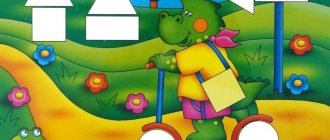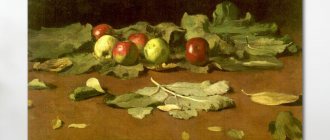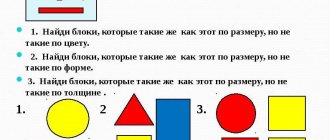No matter how old you are now, adults associate the word “mathematics” with school. Many people remember school lessons, and perhaps their teachers, but few parents can remember math classes in kindergarten. Namely, children from preschool age begin to form elementary mathematical concepts.
Many parents will think, “Why teach a child mathematics from the age of 3?” In our article we will try to explain in detail why a child needs math classes and what he should learn at 3-4 years old.
Learning to count from the age of 3
Taking into account the age characteristics of preschool children, mathematics classes differ significantly from lessons at school. For children attending kindergartens, learning is carried out in a playful way and in specially organized classes; children can reinforce the material with the help of didactic (developmental) games. There are specific tasks for each age group.
Mathematics classes develop children's logic and thinking. What ideas and skills should a 3-4 year old child acquire?
Quantity
At this age, children should understand that many objects consist of separate or homogeneous objects. For example, an adult asks children to find among the many rabbits the same one as he has in his hand.
Next, exercises are offered in which children select and group objects according to certain characteristics, for example: “Put all the blue balls in a basket, small mushrooms in one box, and large ones in another.” By completing tasks, children understand that all objects can be combined according to a certain characteristic.
Learn the concept of quantity from a picture
In order to teach 3-year-old children to understand the words “one” and “many,” the following exercise is proposed: in accordance with the number of children, apples are placed on the table. The adult draws attention to the fact that there are a lot of apples on the table, after which he asks each child to take an apple. The kids see that each time there are fewer and fewer apples, and as a result, “a lot” disappears. The adult says that each child has one apple, but there is not a single one on the table. After the adult invites the children to put one apple back on the table, they get a lot of apples again.
By teaching children 3–4 years old to compare groups of objects, an adult introduces the concepts of “equality” and “inequality.”
The game “Catch the fish” with a certain number.
For this, the overlay technique is used. For example, the card shows 5 kittens. The adult offers to “put” each kitten in a basket, placing a picture with the image of a basket under each kitten. Then he draws attention to the fact that there are “as many” baskets as there are kittens, which means “equally”. By removing one picture of a basket, children understand that there are “more” kittens and “fewer” baskets.
Exercises
Exercise one
Look carefully at the picture of the child and ask him a few questions about the picture.
Find and show the blue rectangle.
Are there red squares in the picture?
What color are the triangles?
Find and show a black circle.
What color are the squares?
What color are the rectangles drawn in?
Exercise two
Look carefully at the picture of the child and ask him a few questions about the picture.
What shapes does the house consist of?
What color are they?
What geometric figure does the sun resemble?
What color is the sun?
Magnitude
Children 3–4 years old learn to compare different objects (blocks, strips of paper, ribbons) in width, length and height, and use the words: “longer - shorter”, “same in length”; “wider – narrower”, “equal in width”; “higher - lower”, “equal in height”; “more - less”, “equal in size”.
Cards for studying quantities “more and less”
At first, children learn to compare objects according to some specific characteristic. So, for example, by placing one ribbon on top of another, the children understand that the red ribbon is longer than the blue one, and the blue one is shorter than the red one.
After children learn to compare quantities and denote them in words, they can play the didactic game “Order”. An adult, on behalf of the doll, asks to bring a tall Christmas tree, a long path, a short ribbon, find a carrot of the same height...
Games on the concept of “more/less” can be bought in the store
Geometric figures
Children 3-4 years old are introduced to the square and circle. To do this, an adult gives each child different colored silhouettes of a square and a circle. Showing, for example, a blue square asks children to find the same figure in themselves. He does the same with a red circle, but does not say the name of the figure. Further examination of geometric figures takes place tactile-motor. The children repeatedly run their fingers along the outline of the figure and say its name.
The easiest way to study shapes is through play.
To reinforce the material, you can exercise the children and offer, for example, to put all the squares on the bottom strip, and the circles on the top; pick up the figure in your hand and name it; put the circles in a tray and the squares in a box or play the games “Guess what’s in the bag”, “Find the house”.
Orientation in space
At this age, children learn to navigate space “from themselves” and learn concepts such as: right (right), left (left), forward (in front), behind (behind), above, below.
When learning orientation in space, parts of the child’s body are taken as a basis: below is where the legs are, above is where the head is, behind is the back, and in front is the face, on the right is the right hand, and on the left is the left. The following exercises will help kids learn to navigate in space: “Wave the chicken with your right hand, then with your left”; “Where did the bunny jump” (up, down the hill); “Pull the flags forward (in front of you), hide them back (behind your back).
Orientation in space using cards
It should be borne in mind that when performing all exercises, all children should face the same direction, and the adult’s movements should be performed in a mirror image.
Time orientation
In everyday life, children learn to navigate time. A good helper will be strict adherence to the daily routine.
An adult introduces children to the parts of the day - morning, afternoon, evening, night. In the process of performing routine tasks, the adult says that it is morning, you and I woke up, washed ourselves, do exercises and have breakfast. Before lunch, you need to say that it is daytime, moms and dads are at work, and you and I are studying, walking, and having lunch.
Toy clock puzzles
To reinforce the parts of the day, you can invite children to look at pictures that will allow them to answer the questions: “What are the guys in the picture doing?”; “When we walk, do we sleep?” When reading works of art, you can invite children to point to a picture that is typical of people’s activities at a certain time of day (day, night, morning, evening).
We hope that all of the above exercises will help adults navigate correctly and contribute to high-quality mathematics classes with preschoolers.
leave a comment
Exercises
Exercise one
Look carefully at the picture; different objects and numbers are drawn on it.
In the first line you need to count the ducklings and connect them with the number.
In the second line you need to count the bunnies and connect them with the number.
In the third line you need to count the squares and connect them with the number.
Exercise two
In this exercise, you need to draw objects against each number.
In the first line, opposite the numbers, you need to draw red balls.
In the second line, opposite the numbers, you need to draw yellow cubes.
In the third line, opposite the numbers, you need to draw green circles.
Didactic games in mathematics for children 4 years of age (Games No. 1-6)
The article Using didactic games in mathematics in the work of a kindergarten teacher is here.
Program content: to form an understanding of the concepts of “many” and “one”, the ability to isolate a single object from a set, to form a set from single objects; introduce the words “many”, “one”, concentrate on the number of objects in the environment.
1. Magic bag
Aids: small plastic dolls (according to the number of players), a truck with a rope attached to make it convenient to transport, a bag.
Progress of the game. The teacher shows the children small dolls and asks what kind of toys they are on the table.
Children. Little dolls.
Educator. I have a lot of dolls on my table. (Calls 2-3 children, invites them to stroke the dolls, see how many there are. Then shows the children a bag and explains that they will now play with this magic bag. The called child hides the dolls in the magic bag).
Educator. Now, children, you will receive one doll from the bag. But the magic bag opens only to those who behave well. Come, Olya, put your hand in the bag and take out one doll. How many dolls have you received, Olya? Show all the children.
Olya. One doll.
Educator. Ira, how many dolls did Olya receive?
Ira. One.
The teacher calls 2-3 children and asks them to complete the same task.
At the same time, he activates other children, invites them to observe the actions of the called children and name how many dolls they will take out of the bag. At the same time, he makes sure that the children do not make mistakes.
Vova pulled out several dolls from the bag. The teacher helped him separate one doll, and the child put the rest back into the bag. Children with dolls go to their places.
Educator. You children behaved well, so now the bag will open for everyone. (With these words, he goes around all the children so that the other children also take one doll for themselves). You all have one doll, show them. Now we will take the dolls for a ride in the car. Whoever the car pulls up to will put his doll in the car. (He slowly drives the car past the children, and they take turns putting their dolls in it.) Vitya, how many dolls did you put in the car?
Vitya. One.
Teacher (asks 1-2 more children, and then addresses everyone). Look, children, how many dolls are in the car now?
Children. A lot of.
At the end of the game, the teacher invites the child to take all the dolls by car to the toy corner.
2. Game with flags
Aids: flags (according to the number of players).
Progress of the game. The teacher shows the children flags: “Look, children, how many flags I have (gives 1-2 children to hold them). There are so many flags that they don’t fit in Olya’s hands.”
Teacher (takes one flag). I'll take one checkbox. How many flags did I take?
Children. One.
Educator. Now each of you will take one flag. Natasha, take one flag. And you, Igor, take one flag.
Misha wants to take two flags. The teacher corrects him: “Take one flag, this is one flag.”
Children walk around the room with flags, wave them, and sing a song about the flag.
The teacher calls the children to him: “Now you yourself will put the flags in the vase. Sasha, how many flags have you checked?”
Sasha. One.
Educator. And you, Igor, how many flags did you check?
Games One.
Educator. Everyone put up one flag and there were a lot of them again. How many flags are there?
Children. A lot of.
3. Play with the pyramid
Benefits: identical pyramids (one for each player).
Progress of the game. The teacher shows the pyramid and invites the child to play with it; places a pyramid in front of himself and the child. Then he removes all the rings from his pyramid, takes them with his hands, and says that there are many of them. The teacher invites the child to remove the rings from his pyramid and play with them, saying that he also has a lot of them. Next, the teacher finds the largest ring in himself, shows it to the child and puts it on the rod of his pyramid, saying: “I put on one ring.” Helps the child find the same ring and says: “And you put on one ring.” Then the teacher finds himself a slightly smaller ring and, putting it on, again says: “I put on another ring.” The teacher invites the child to find the same ring in his home and put it on the rod.
The teacher accompanies the child’s actions with the words: “How many rings did Vitya put on?” “And Vitya put on another ring,” says the teacher if the child is silent. When the toy is composed, the teacher Fr.
4. Save the bunnies from the fox
Benefits: silhouettes of bunnies cut out of paper (one for each child), a toy fox.
Progress of the game. The teacher shows the children bunnies (all silhouettes are installed on a tray): “Look how many bunnies have gathered. Is it really a lot?"
Children. A lot of!
Educator. Now each of you will take one bunny. Igor will come over first. How many bunnies did you take? (One). And now Katya. Vasya, how many bunnies did Katya take? (One). And Lisa will take the same number of bunnies as Katya took. How many bunnies did you take, Lisa? (One). Now I'll go to each one. You, too, take one bunny each. Let all the bunnies jump in the clearing.
Children squat down, place bunnies at their feet and make movements as if bunnies are jumping.
Educator. How many bunnies are jumping in the clearing?
Children. A lot of.
Teacher (places a toy fox near a flower pot). Look here. Who is that sitting under the bush?
Children. Chanterelle.
Educator. How many chanterelles?
Children. One.
Teacher (puts the fox near the bunnies). Look, the fox is sneaking up on the bunnies, she wants to eat them. Save the bunnies from the fox (makes a movement as if the fox is rushing at the hares. Children run to their chairs).
Educator. Saved the bunnies from the fox? You see, fox, you are alone, but there are many of us. We won't let you see the bunnies.
5. Chickens and rooster
Benefits: paper hats for “chickens” and “rooster”. The “chicken coop” is fenced off with chairs.
Progress of the game. The teacher put on the children hats representing the head of a chicken, and on one child a hat representing the head of a cockerel.
Educator. You are all chickens, and Kolya is a rooster. There are many chickens, but only one cockerel. Cockerel, go to the “chicken coop” and call the chickens.
The cockerel goes behind the fence from the chairs and calls the hens “Ko-ko-ko!” The children go behind the fence.
Educator. How many chickens are there in the chicken coop?
Children. A lot of.
Educator. How many cockerels?
Children. One.
Teacher (goes aside and calls the chickens). Chick-chick-chick! Eat grains. Cockerel, call the hens, this is where I poured the grains.
The cockerel is calling the hens. The children come up and pretend to peck at the grains. At the end of the game, the cockerel takes the hens for a walk.
Educator. It's already late. Cockerel, take the hens to bed!
The children go behind the fence.
Educator: What a big chicken coop. There are a lot of chickens, but they are all housed. Are there really a lot of chickens?
Children. A lot of.
Educator. Are there a lot of cockerels too?
Children. There is only one cockerel.
6. Guess where there are many and where there is one
You will need: two buckets of different colors, small items (one in the red bucket, many in the green), two napkins, a screen.
Progress of the game. Educator. Children, do you know what's in these buckets? No? Volodya, come here, tip over this bucket, let the children see what was in it.
The children see that one chestnut has fallen out of the bucket.
The child called further shows that there were many chestnuts in the second bucket.
Educator. What color bucket was there one chestnut in? (In red). Which bucket contained a lot of chestnuts? (In green).
After this, the teacher, using a screen so that the children do not see, pours many chestnuts into a red bucket, and one into a green one. Cover the buckets with napkins.
Educator. Children, do you remember which bucket contained one chestnut?
Children. In red.
Educator. Go, Tanya, show me.
Tanya (approached). Here in this red one.
Educator. Dump the bucket and show how many chestnuts are in it now.
The children see that there are now a lot of chestnuts in the red bucket. And then they make sure that there is only one in the green bucket.
Toys can be replaced, baskets can be given instead of buckets, and other children can be invited.







